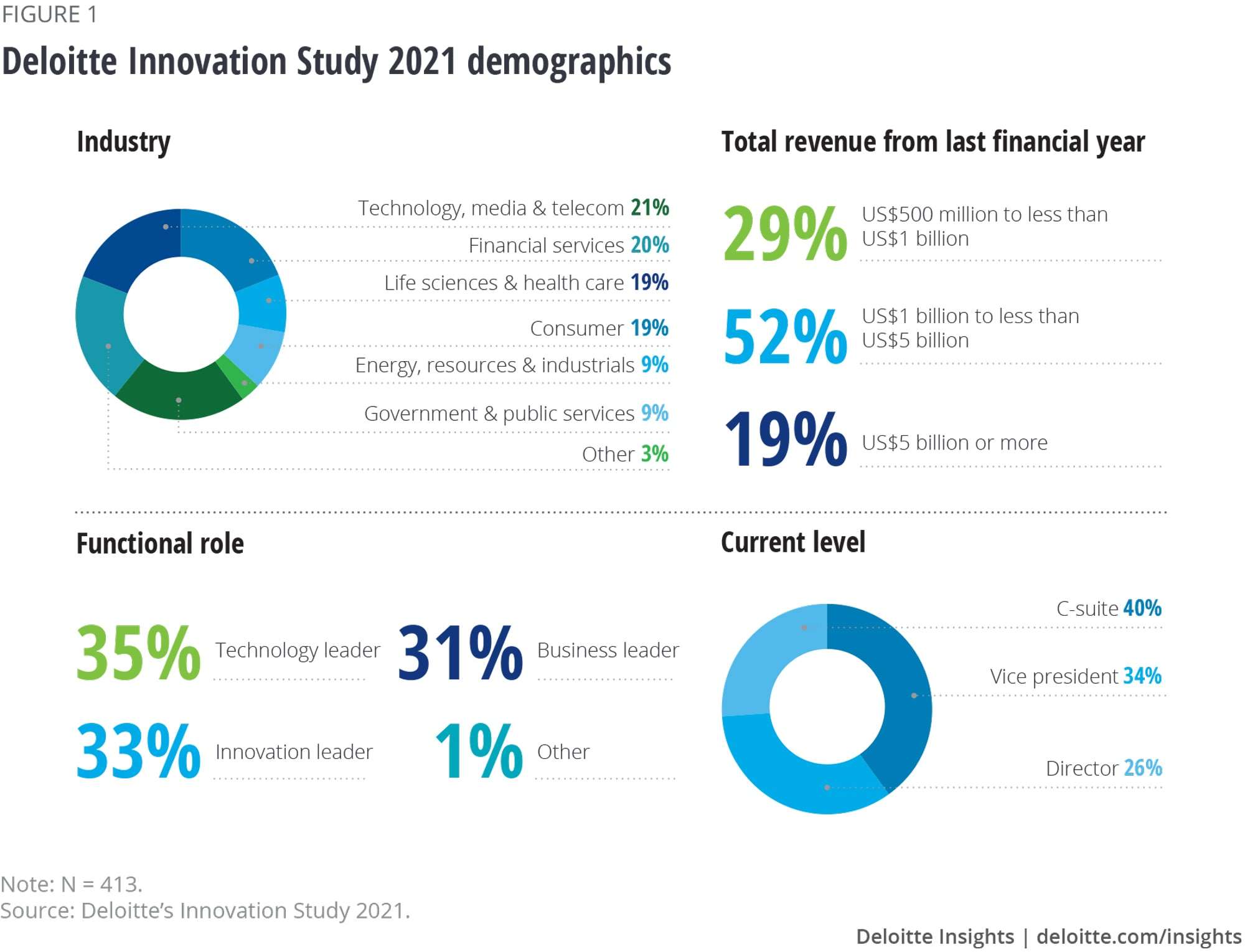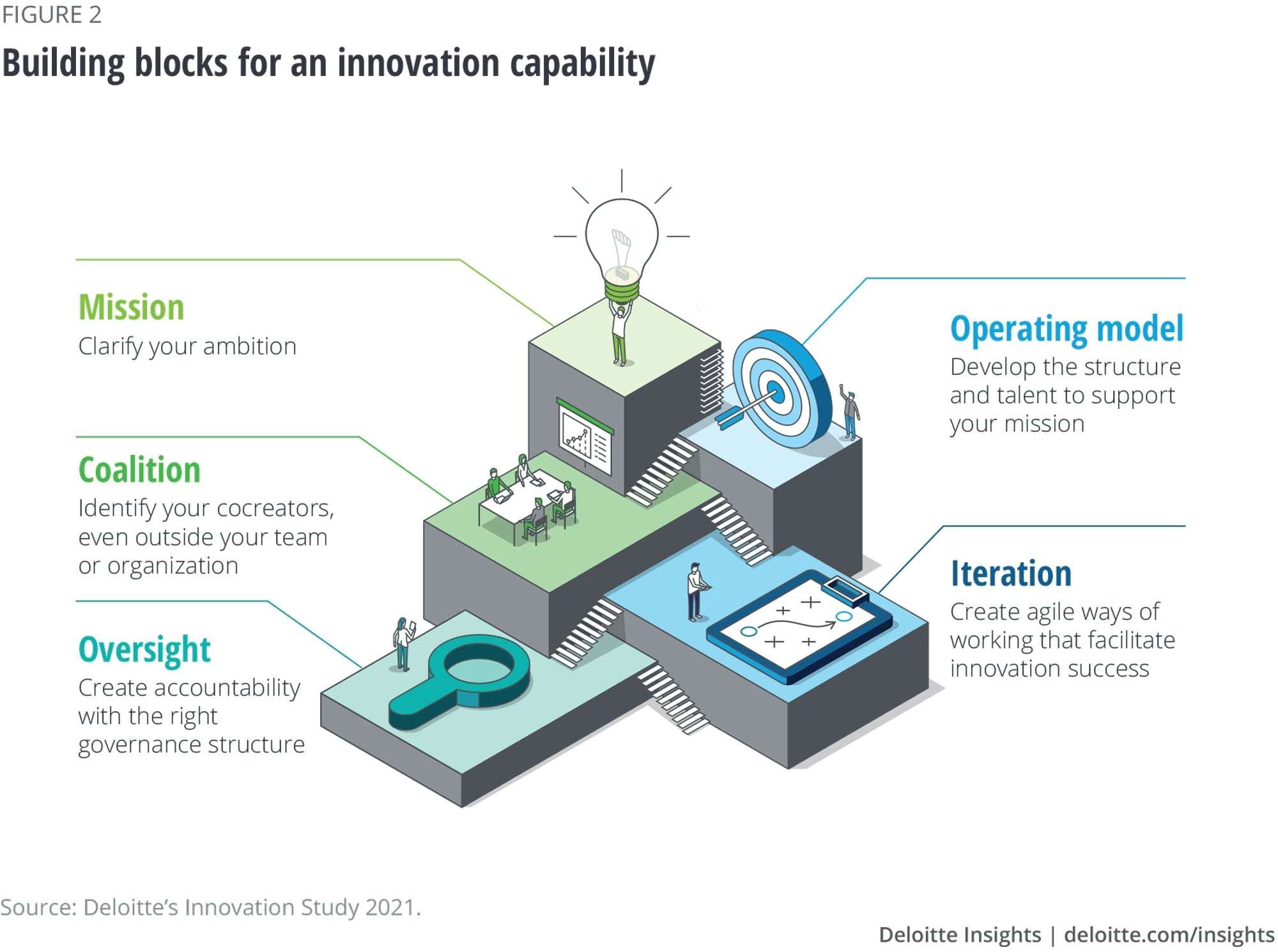Successful innovation functions display unique characteristics, one of them being technology’s prominent role in driving these initiatives. How can CIOs and technology leaders seize this opportunity and ensure they play a pivotal role in their company’s growth?
Many enterprises now have an innovation function, whether it be a team that is dedicated to seeking out new opportunities or an executive tasked with finding new ways of working. But according to the latest Deloitte survey, only half of innovation efforts are achieving their desired value, and companies with successful innovation functions have unique characteristics.1 The study revealed that most leading companies view innovation as something both new—which can include new applications of existing tools—and improved—which may mean simply a measurable advance over legacy alternatives. This covers everything from incremental gains to moonshots.
Deloitte’s Innovation Study 2021 found that 80% of CIOs and tech leaders say they are driving their companies’ innovation efforts.2 The next most common roles involved in innovation were strategy at 48% and operations at 43%, indicating that technology is by far the primary function driving enterprise innovation. CIOs are uniquely positioned to fuel their company’s growth, as they are already responsible for high-growth initiatives like data monetization and digital transformation. With nearly three quarters of organizations expecting to have an excellent or leading innovation capability in the next two years, CIOs should develop a methodical approach to innovation that can lead to differentiated growth.
About Deloitte’s Innovation Study 2021
Deloitte’s Innovation Study 2021 surveyed more than 400 tech, innovation, and business leaders to understand their approaches to innovation and developed clear recommendations for taking innovation from ideation to industrialization. By looking specifically at the responses of tech leaders and how they differ from other respondents, we developed further insights in this article on how effective CIOs are making an impact. Through interviews with survey respondents who work in technology roles, we also noticed several common approaches to innovation, which highlight how it has different demands compared to other business initiatives.

Get in the Game: Five Key Differentiators of Successful Innovation Programs
The lion’s share of innovation efforts today are aimed at one-off projects. These may occasionally deliver exciting new revenue sources, but Deloitte’s research shows that leading innovators take a more programmatic and focused approach; for example, Deloitte’s Ten Types of Innovation provides a discipline for identifying new opportunities.3 When we refer to “leading innovators,” our study considered two dimensions/descriptions of leadership in innovation: growth and maturity. Specifically, this included those (for-profit) companies that grew their revenues more than 20% in the last year (10% of respondents) and those organizations that self-reported as having leading innovation capabilities (8% of respondents).
While innovation has some unique characteristics, it shouldn’t be totally disconnected from how organizations build effective capabilities generally. We identified five key attributes of building a capability that can distinguish successful innovation programs.

Clarify the mission
Tech leaders should be clear on what they want their innovation efforts to achieve. On the one hand, innovation demands a certain level of experimentation. On the other hand, CIOs are traditionally responsible for delivering operational tools. This tension must be acknowledged at the early stages of new initiatives. Absent a sharp focus, innovation programs can become haphazard and fail to deliver meaningful impact.
Clarity of mission also keeps the focus on activities that grow the business. After all, tech leaders can have a bias toward defensive approaches to innovation. In Deloitte’s Innovation Study 2021, CIOs were more likely to report that the primary focus of their innovation is cost reduction or efficiency gains, compared to business leaders (33% vs. 27%).
But at high-growth companies, the focus of innovation is more likely to be on activities that grow revenue (38% of high-growth companies vs. 25% of all respondents). This includes more forward-looking activities that lead to new products or services that fundamentally change how the business operates. Case in point: successful innovators are more likely to “lead with need,” by uncovering customer and stakeholder issues (23% at high-growth companies vs. 18% of total respondents), and less likely to focus their efforts on process optimization (33% vs. 40%).
Jen Hartsock, CIO at Baker Hughes, differentiates between capital “I” innovation, which is highly methodical, often sponsored by the organization using formal business practices, and lowercase “i” innovation, which is something that anyone can do by finding places they can contribute to drive change and process improvements.
Both types of innovation programs can deliver value, but it is important to understand and align on the mission for your innovation program, because each of these could require different operating, funding, and governance models. Many technology leaders invest in prototyping and experimenting with emerging technologies, only to find that they don’t have a tangible financial return. Leadership should agree on whether this is an acceptable outcome at the outset.
Build the right operating model
Tech leaders developing innovation capabilities should decide whether the function will be centralized or decentralized. Both approaches have their pros and cons, and the decision may come down to the ultimate goals of the initiative or the industry in which they operate. Our study found that industries with historically intense R&D functions, such as chemical, physical, and geological science and engineering, are more likely to use a centralized structure. Other industries, including technology, media & entertainment, and telecom, typically use hybrid structures.
The decision to centralize or decentralize may come down to the skills you have available in-house. If your initiative needs particular skill sets that are already being utilized in other areas of the business, a centralized and shared function may be best.
Regardless of the team structure, tech leaders engaging on innovation often need people who have the soft skills to facilitate collaboration. In Deloitte’s 2020 Global Technology Leadership Study, CIOs said they are increasingly looking for three skills: cognitive flexibility, emotional intelligence, and creativity.4 In the context of innovation, these skills are right at home. In our Innovation Study 2021, we found that teams need to be open to new ideas, connect with others throughout the organization, and seek out new ways of working. Bringing together people with these skills should be a priority when building the innovation team’s operating model.
Establish agile ways of working
The process of developing new innovations is always going to be iterative. Agile approaches are most likely to pay off. Agile is all about developing new tools or processes in a stepwise manner by cross-functional teams, as described in Deloitte’s report, The product shift.5 This is a good match for innovation, which also works well when teams work collaboratively toward solutions in an iterative process, identifying new and useful learnings along the way. A series of small targets is likely to deliver stronger and more useful innovations than laying down a single long-term goal.
In particular, tech leaders should avoid making financial returns from their innovation functions an immediate goal. ROI comes later. Demanding tangible results from early-stage innovations risks killing potentially impactful products or services before they have a chance to fully mature. This doesn’t mean skip measurement entirely, but rather is a call for patience. Interviews with survey respondents showed that they are more likely to gauge the initial impact of their innovation teams through alternate measures, like how many proof-of-concept projects they run, or the number of pilots they implement.
Longer term projects with fewer interim goals may be necessary in a few areas, such as drug development, which has a lengthy regulatory process and requires a long runway. But many organizations will find that agile, iterative processes can help them home in on value much quicker.
As one innovation leader put it, “I prefer to get innovation done quietly and be louder once it’s creating revenue.”
Find “outside” coalitions
CIOs were more likely than their business counterparts to say that intrapreneurship will deliver the most value over the next two years (37% vs. 29%). But this could constitute a blind spot for tech leaders, who may have a bias toward what they build themselves. Instead, innovation should be collaborative and IT leaders should look to partner with lines of business on developing this capability. This is a good foundation for innovation functions, because it sources diverse ideas and skills from across the organization.
In fact, half of organizations with a leading innovation capability said ownership of that function was spread throughout the organization, compared to one-third of respondents overall. Partnerships with finance can prove especially fruitful. Our survey showed that 45% of high-growth companies have finance involved in innovation initiatives, compared to just 30% of overall respondents. Innovation needs funding and it needs the people who control the money to be on board with the mission.
CIOs driving innovation efforts should also consider reaching outside their own organizations to solicit expertise. Tech leaders should engage with their ecosystem partners as part of “outside-in” thinking to get a sense of how others view their challenges and opportunities. Organizations shouldn’t limit themselves to the skills they have internally. As described in Deloitte’s report, Beyond innovation by shotgun,6 outside partnerships can augment existing capabilities or provide entirely new capabilities that an organization doesn’t have the resources to create. There are a range of potential partners, including universities and innovation hubs, to name a few. The expertise of these outside organizations can greatly expand existing innovation efforts.
In essence: avoid going it alone. This means sharing some of the rewards but also some of the risk.
“You cannot do anything in the innovation space without a combination of business and technology,” said Priyanka Pushkarna, director of emerging technologies at Verizon.
Create accountability
The types of governance structures that work for other projects or areas of the business might not be well-suited to innovation. Tech leaders should pay particular attention to how they structure, fund, and measure the impact of innovation functions.
Innovation teams need space and freedom to explore ideas. Tightly controlling them through frequent meetings or expectations around return on investment (ROI) runs the risk of killing good ideas before they have a chance to flourish. On the other hand, letting innovation teams run too freely could lead to excess waste and a lack of impact.
A big part of getting this right comes down to funding. Our survey showed that high-performing innovation teams operate on iterative funding models. This approach is borrowed from venture funding, which gives teams new rounds of funding for checking off certain intermediate goals, not necessarily accomplishing their entire mission or proving ROI. In other words, it keeps teams hungry. “Identify short term pockets of value creation that allow you to fund growth and your team, instead of asking for lump-sums of money you can’t put to use,” said Renato Mazziero, vice president of Experience and Innovation at Thrivent.
It’s still important to hold innovation teams accountable for certain deliverables. In our study, enterprises with mature innovation programs were more likely than average companies to set targets and measure against them (50% vs. 30%). But these targets should be more iterative and less tied to traditional business metrics.
Organizations may take different approaches to measurement depending on the maturity of their innovation programs. Initially, the focus should be on activity, but as programs mature, they can start measuring more outcome-based targets like ROI or value created.
Lessons from the Trenches
Tech leaders often approach innovation differently from their colleagues on the business side. In some instances, this can be a benefit, as they have a unique perspective on how technology can enable new ways of getting things done. To grow a successful innovation function over time, technology leaders should follow the lead of their high-performing peers.
Take a big swing. Alexander Aravanis, CTO and senior vice president at Illumina, takes a unique approach to vision: His team tries to build a road map of how the world will look in 5–10 years and develops products for projected future needs.
“We make big strategic bets, but we try to do it in a smart way,” Aravanis said. “They’re big investments. They’re very farsighted things that could take many years to play out, but we think it’s the right fundamental direction.”
Anticipate failure. Innovation teams walk a fine line when it comes to measurement. They need to feel comfortable trying big things that might not work out. Otherwise, people won’t give voice to new ideas. “Setting out to conquer what is difficult doesn’t always pay off,” Aravanis said, “and fostering a company culture that punishes failure results in defensiveness and discourages tenacity.” According to our study, organizations with leading innovation maturity are more likely to consider failures as positive and celebrate lessons learned (78% vs. 54%).
This doesn’t mean that innovators get a blank check to experiment without ever worrying about results. Aravanis said it’s important to track the impact of moonshot projects over time and not be afraid to pull the plug on anything that simply isn’t working. Deloitte’s Innovation Study 2021 backs this up: Fifty percent of companies with mature innovation programs set targets and measure their ability to convert new ideas into products, compared to just 38% of overall respondents.
Establish air cover. In Deloitte’s Innovation Study 2021, 44% of survey respondents with a leading innovation function said their C-suite is completely aligned with their innovation agenda, compared to 36% of total respondents.
“We learned that when you work too independently from the business, somebody owns every space we’re touching. There’s a certain human nature in pushing things away that you weren’t involved in from the ground floor,” says one of our interviewees.
Mash up cultures. Tech leaders should look for opportunities to add as many diverse perspectives as possible to innovation teams. “I don’t know how you do great innovation without diverse perspectives,” says Hartsock. This includes both demographic diversity as well as diversity of experience. People with different skills will likely approach a product from new angles and potentially expose problems in its functionality. Adversarial red teams may expose security vulnerabilities. The input of all these different people through an iterative process can lead to a more solid product in the end.
Hartsock said that innovation springs from the collision of different ideas. “That’s where the magic happens,” Hartsock said. “If it were something we all agreed on, that would be the safest innovation we’ve ever done. But that’s not where change comes from.”
Invest in experiments. Many areas of business look to bring in mature technologies that are ready to deliver value immediately, but this can be a limiting mindset when it comes to innovation. Pushkarna said her team is experimenting with the latest advances in technologies such as augmented and virtual reality, even though some of the use cases might be exploratory. The reason being that experiments could lead to learnings that pay off down the road.
“In some cases, you prepare for the opportunities that the technology might award, knowing fully well that it may not be ready for adoption,” Pushkarna said. “It’s about using a portion of your portfolio for identifying opportunities and exploring the art of the possible.”
Meeting the Challenge
Corporate innovation efforts at large companies often lack clarity of mission and a structured process to assess, incubate, and iterate new ideas. Tech leaders are increasingly being asked to not just drive and contribute to innovation programs but also to bring rigor, structure, and focus to existing efforts. Accomplishing this across the innovation life cycle and scaling solutions to drive corporate growth is not an easy task—but savvy CIOs know that it is the only way for them to differentiate and deliver impact. Tech leaders should view this as an opportunity to rise to the occasion and push their organizations to new frontiers of growth.
- Mike Bechtel, Khalid Kark, and Nishita Henry, Innovation Study 2021: Beyond the buzzword , Deloitte Insights, September 30, 2021. View in Article
- Ibid. View in Article
- Doblin, “Ten Types ,” accessed October 1, 2021. View in Article
- Khalid Kark et al., The kinetic leader: Boldly reinventing the enterprise , Deloitte Insights, May 18, 2020. View in Article
- Khalid Kark et al., The product shift: Rewiring the organization to maximize business value , Deloitte Insights, November 16, 2020. View in Article
- Khalid Kark and Bill Briggs, Beyond innovation by shotgun , Deloitte Insights, April 26, 2019. View in Article
We would like to thank: Ed Burns for helping us craft the story with your narrative mastery and eye for detail. Kenneth Akpati for your expert review of this material and your championing of “new and improved” innovation throughout Deloitte. Kelly Gaertner and Abhijith Ravinutala for your operational support and execution in getting this over the finish line. Rithu Thomas, Preetha Devan, Blythe Hurley, and the entire Deloitte Insights team for continuing to provide outstanding editorial and production support.
The article was first published here.
Photo by Javier Miranda on Unsplash.

 5.0
5.0 





















